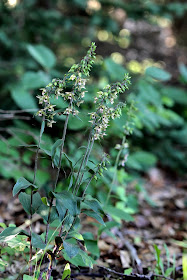These three weeks were spent traveling cross-country to a youth camp and to visit family and there were few opportunities for orchid hunting, so I've combined the three weeks and the few orchids we saw into one post.
This week was spent driving to a young people's camp in eastern Washington and then to Yellowstone National Park, followed by a long and hurried drive across country to Michigan and Indiana to see family. Not much time to go orchid hunting and not many orchids to find except some or Bog Orchids.
Platanthera stricta, the Slender Bog Orchis, was at the peak of its blooming season in the Cascades and I made several stops to photograph them. This is a rather nondescript species with small green flowers that is so common we do not always even take the time to photograph it.
We also found Platanthera dilatata in the North Cascades and again in Yellowstone National Park. The variety we found growing in the North Cascades, however, was Platanthera dilatata var. dilatata, distinguished by a spur that is approximately the same length as the lip.
In Yellowstone we found that variety as well as Platanthera dilatata var. leucostachys, distinguished by its very short spur, very much shorter than the lip. This species is very common wherever it is found and though beautiful and fragrant is another species that we do not always take time to photograph.
In one area, growing with the Bog Candles, Platanthera dilatata var. albiflora, the were a number of plants of Platanthera huronensis, the Green Bog Orchis. The two speciers look quite similar but the Green Bog Orchis is different in color and the shape of the lip.
We also found one plant of Spiranthes romanzoffiana, the Hooded Ladies' Tresses, another common Yellowstone species, in bloom near one of the hot springs, probably encouraged to bloom early by the heat of the spring since this species usually does not bloom until August.
July 7-13
This second week was spent with family including a few days camping on the shores of Lake Michigan. We found one orchid which seemed to be everywhere in the sandy areas along the lake and which was just starting to bloom, Epipactis helleborine, the Broad-leaved Helleborine.
This orchid is not actually a native, but a European import which has spread across the northern United States and southern Canada and in some areas has the status of a weed. We have found it here in Washington in several location, but it was even more common is western Michigan.
July 14-20
The first part of this week was spent with family and the latter part of the week driving home, so there was almost no opportunity for orchid hunting. On the last leg of our trip, however, we caught up with some of the members of the Washington Native Orchid Society for a hike in the Cascades.





















BRAVO ON THAT 2nd TO LAST SHOT
ReplyDeleteI see the bug !
8-D
That one was put in just for you, Marti. I think I've told you before that I used to knock them off. Now I leave them on and you taught me that. Much more interesting that way.
DeleteHow big is that plant? Looks the size of Hammarbya paludosa or Chamorchis alpina(5-10cm).
ReplyDeleteCongrats on finding the rare plant in such a remote place!
It's only about 10 cm tall, Martin, and very difficult to find for that reason and because it tends to grow under other plants. We've found it now at three remote mountain lakes in that area.
DeleteWhat a strange orchid, that last one! Thanks for sharing. I don't think I've even heard of it...
ReplyDeleteJim Fowler, Greenville, SC
Thanks, Jim, for looking and commenting. The Platanthera is indeed an odd one and so very difficult to find. We've hunt for it where we knew it was and still could not locate it.
Delete